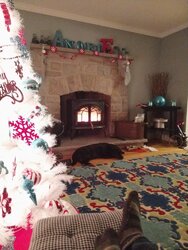Good evening, hearthers. Three years ago, I put up about 6 cords of various hardwoods scavenged from the local DOT trimming efforts. I knew it needed to season, so it's been split/stacked uncovered the whole time. Fast forward to this fall- I bought a stove and had a liner installed, thinking my wood was sure to be seasoned by now.
It's not.
I'm getting very inconsistent ease-of-startup, burn times and temperatures, and have to leave the air cranked wide open to get my Isle Royale to perform. Most telling, I frequently have the telltale hissing of steam well into a burn.
I'm at a loss for how my pile isn't dried. I have taken steps to prevent any seasonal moisture from accumulating by tarping about 2/6cords.
I'll note that I have had some great fires with some of the wood being obviously seasoned- ripping hot with little primary air... active secondaries. But it seems like that is happening less frequently the deeper I get into the pile.
Your thoughts and help are appreciated.
It's not.
I'm getting very inconsistent ease-of-startup, burn times and temperatures, and have to leave the air cranked wide open to get my Isle Royale to perform. Most telling, I frequently have the telltale hissing of steam well into a burn.
I'm at a loss for how my pile isn't dried. I have taken steps to prevent any seasonal moisture from accumulating by tarping about 2/6cords.
I'll note that I have had some great fires with some of the wood being obviously seasoned- ripping hot with little primary air... active secondaries. But it seems like that is happening less frequently the deeper I get into the pile.
Your thoughts and help are appreciated.
Attachments
Last edited:



 Plus I am dealing with a large percentage of “lesser” quality species this year - that ain’t helping. Gotta go...stove is hungry again.
Plus I am dealing with a large percentage of “lesser” quality species this year - that ain’t helping. Gotta go...stove is hungry again.